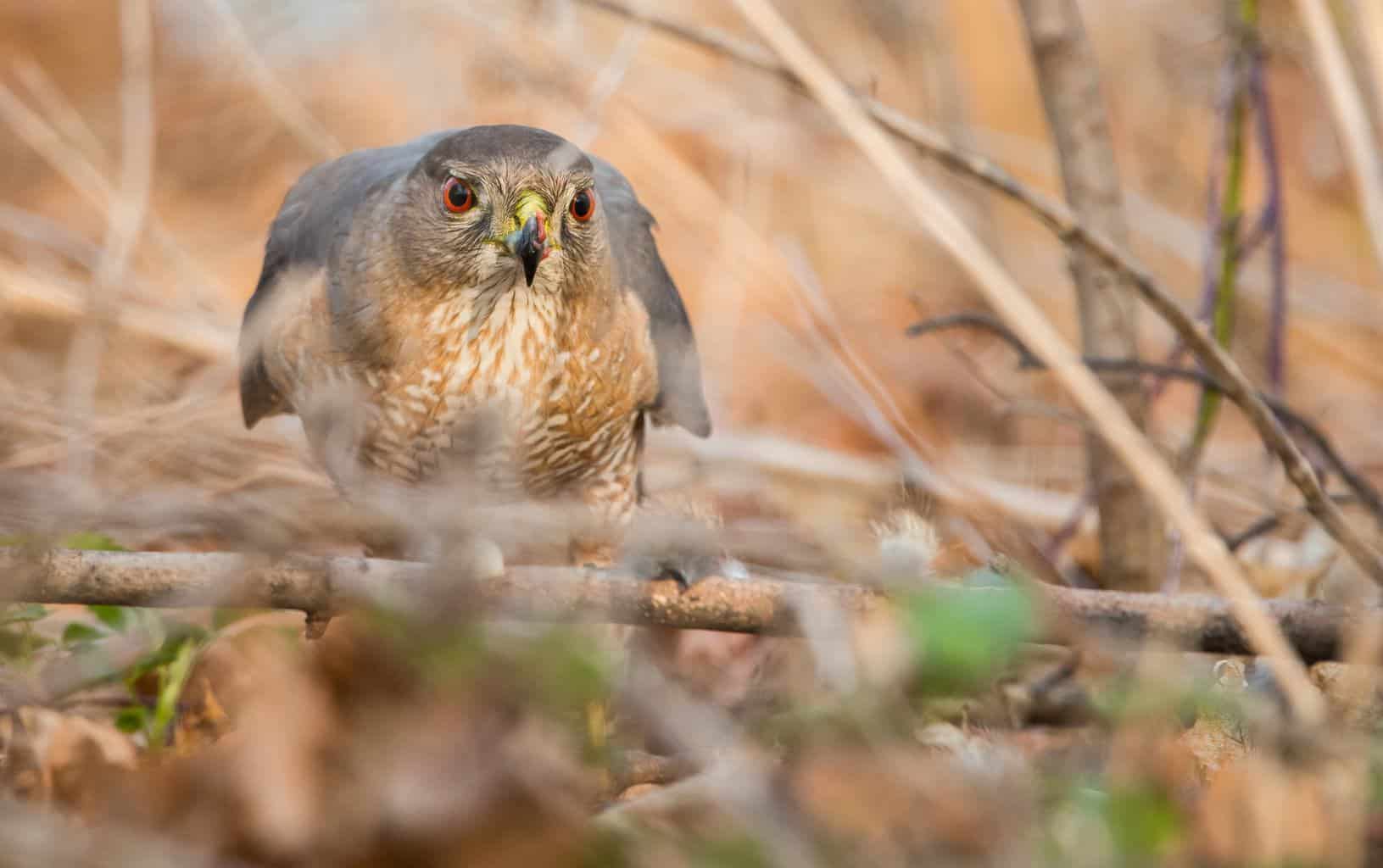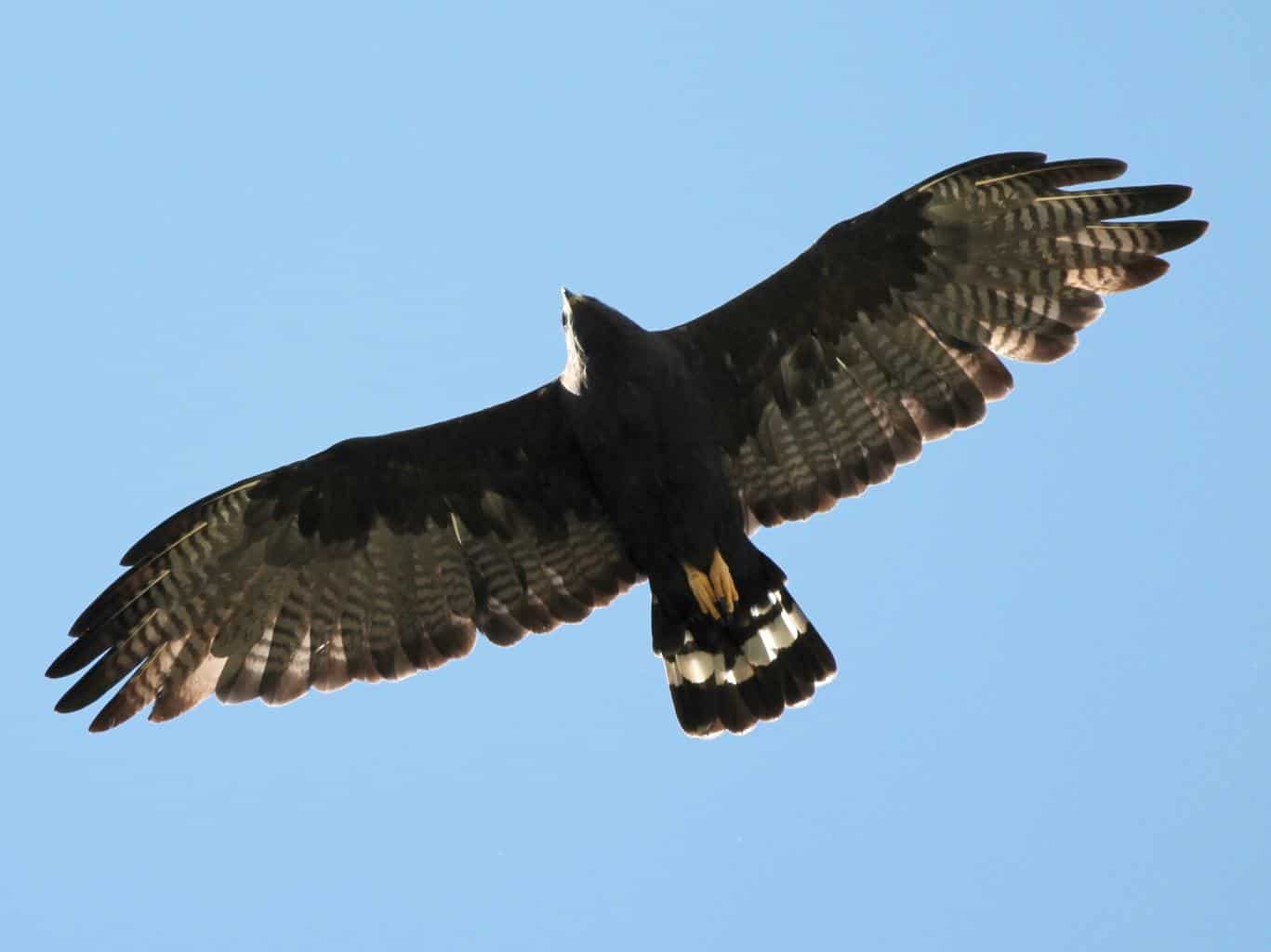As it turns out, the state with the highest population density in the United States, New Jersey, houses more than just people. It’s also home to all kinds of raptors, including eagles, owls, and hawks.
According to New Jersey Audobon Cape May Bird Observatory, there are at least 150 raptors spotted in the state every month, but for the sake of time and avoiding information overload, we’re only going to focus on the magnificent birds that reach 150 miles per hour when diving for prey: hawks!
Whether permanent residents or transient migrators, 8 species of hawks seem to freely roam the skies of New Jersey, and now, without further ado, we’ll introduce you to all of them.
Northern Goshawk

- Scientific name: Accipiter gentilis
- Length: 18 – 27 inches
- Weight: 26.736 – 77.6 ounces
- Wingspan: 35 – 50 inches
First on our list of New Jersey hawk species is the northern goshawk. This well-established raptor is harnessed for falconry, which means people use these birds of prey to hunt other birds and animals.
This mighty bird is identifiable by one of two color combinations — blue-grey or brownish-grey. You’ll likely see this species in its favorite habitat, wooded, thick forests. They love to spend so much of their time here because forests constitute fertile lands for hunting. Northern goshawks also like to have access to open areas where they can take their game to other birds.
The Northern Goshawk is a well-established raptor that people harness for falconry. This means they use the Goshawk to hunt birds and animals. This mighty guy is identifiable by one of two color patterns: blue-grey and brownish-grey.
Cooper’s Hawk

- Scientific name: Accipiter cooperii
- Length: 14 – 20 inches
- Weight: 9.76 – 19.968 ounces
- Wingspan: 24 – 39 inches
Cooper’s hawk can be identified by its wedge-like tail and its small, hooked bill. Using a bird’s colors to identify a hawk can prove to be challenging, as so many species share very similar looks, but you’ll know Cooper’s hawk by its brown, blue-grey, or blackish-brown feathers and white undersides.
Channel your inner bird enthusiast when you’re in areas with patchy woodlands or riparian forests, which are forests that lie next to a body of water.
The Natural Resources Conservation Service in New Jersey is actually making efforts to encourage forestry. That includes riparian forests that have a huge environmental role to play. How does this relate to this bird species, you ask? Well, that means there will be a larger habitat for our friend, the Cooper’s hawk…hallelujah!
Sharp-Shinned Hawk

- Scientific name: Accipiter striatus
- Length: 9.1 – 15 inches
- Weight: 2.9 – 7.7 ounces
- Wingspan: 17 – 27 inches
If you’re a bird enthusiast on a mission to spot the sharp-shinned hawk, you’ll want to first check its main habitat, the forest — specifically, in aspen, fir, and pine forests. This means you’ll most definitely encounter them in the one-million acres worth of pine forests in New Jersey: Pine Barrens.
This species is the smallest hawk in North America, but for being so small, they’re remarkably strong. In case size isn’t enough to identify these tiny raptors flitting about the trees, note their bluish-gray feathers and white and brown underparts.
Because sharp-shinned hawks are fairly secretive birds, there isn’t much information known about their reproduction. What is known, though, is that they’re monogamous. Maybe that loyalty is why the female rewards the male by doing most of the nest-building.
Rough-Legged Hawk

- Scientific name: Buteo lagopus
- Length: 18 – 24 inches
- Weight: 21.12 – 58.56 ounces
- Wingspan: 47 – 60 inches
The rough-legged hawk is one of the largest of the buteo hawks. Compared to its fairly broad wings, it has a narrow trunk, and it sports dark brown feathers on its back and a dark-tipped tail.
When it’s time to eat, the rough-legged hawk sets out in pursuit of rodents, especially lemmings. In fact, how available lemmings are to this species dictates the number of eggs this hawk lays. When lemmings are abundant, they increase the hawk’s offspring and give it a means of survival while it’s living in cold areas where food is scarce.
As soon as mating season rolls around, males of this species put on a real show of circling and soaring to attract a partner. But before any sparks fly between a pair of these birds, they migrate alone until they reach a suitable place to mate.
Zone-Tailed Hawk

- Scientific name: Buteo albonotatus
- Length: 18 – 22 inches
- Weight: 19.936 – 38.096 ounces
- Wingspan: 46 – 55 inches
Although the dark-colored zone-tailed hawk sports a bright yellow beak and legs, its physical appearance is not what’s most notable about this species of hawks. Instead, it’s most known for its aggressive behavior that’s on full display when two males compete over a potential habitat for breeding. There’s circling, talon grappling, tumbling, screaming — you name it!
Besides breeding season, zone-tailed hawks also get exceptionally aggressive during the nesting season. This time, both the male and the female team up to defend their nest. This is exacerbated when there are nestlings that are too young to leave the nest.
To attract the female, the male hawk engages in picturesque air maneuvers that include dives, loops, and rolls.
The zone-tailed hawk feeds on birds and mammals alike. Its favorite dish among birds is passerines, while its favorite mammals to eat are chipmunks and squirrels.
Red-Tailed Hawk

- Scientific name: Buteo jamaicensis
- Length: 18 – 26 inches
- Weight: 24.32 – 60.784 ounces
- Wingspan: 3 ft 5 – 4 ft 8 inches
The red-tailed hawk is one of the most common hawk species in all of North America, it should come as no surprise that it can be seen in New Jersey year-round. You’ll recognize this large, broad-winged buteo by its wide, short tail. Although it’s called “red-tailed,” the bird’s tail isn’t exactly red; it’s pale-brown, bordering on cinnamon-red.
Though they can be found in the open country and woodland areas, the red-tailed hawk population isn’t just confined to the forest. You might spot one while at an urban park as it sits perched on a nearby telephone pole. That’s how this species hunts: it settles on high grounds, scanning the vicinity for potential prey.
What kind of prey is it searching for, you ask? That depends on the day, as this bird isn’t too picky. The red-tailed bird’s diet mostly consists of small mammals, birds, and reptiles, but when available, they’ll eat bats, frogs, and insects.
Broad-Winged Hawk

- Scientific name: Buteo platypterus
- Length: 13 – 17 inches
- Weight: 9.3 – 19.8 ounces
- Wingspan: 29 – 39 inches
When they’re perched, the wings of the broad-winged hawk don’t seem quite so broad, with the tail typically outmatching them. But as soon as they stretch out their wings, you’ll see they’re indeed pretty wide and have pointed tips.
This bird is dark in appearance, sporting a back that’s tinted with brown feathers and underparts that are pale with cinnamon stripes.
The preferred habitat for our broad-winged friends is dense forests. However, it wouldn’t be accurate to call them friends, as they’re pretty timid and tend to avoid humans, even though they like to roam the skies of open areas where they hunt.
Red-Shouldered Hawk

- Scientific name: Buteo lineatus
- Length: 15 – 24 inches
- Weight: 19.36 – 24 ounces
- Wingspan: 35 – 50 inches
Though other species of hawks flaunt red-feathered shoulders, the red-shouldered hawk has other features that really set it apart. For instance, the redness in the red-shouldered bird extends to its chest while its belly retains a pale color.
Like the broad-winged hawk, these birds of prey have red-tinted chests. However, they differ in the fact that the red-shouldered bird has more of the pale color on its feathers, and the broad-winged bird’s wings are more pointed.
The red-shouldered hawk is the noisiest of its kind, especially when it’s time to attract a mate, and its hunting zone is the undergrowth of the forest. There, it feeds on lizards, frogs, small mammals, and snakes.
Final Words
Hawks have been associated with humans since forever, thanks to falconry, where they became our loyal hunting partners. Their powerful presence is a breathtaking sight, and in New Jersey, we’re sure there will be plenty of those sightings. Hawks are abundant in New Jersey because it offers them the habitat they need, be it forests like the Pine Barren, or open, agricultural spaces.
Do you know what else can be readily found in this marvelous state of New Jersey? The similarly marvelous woodpeckers! Indeed, New Jersey is a city rich with birds, that no birder should ever miss on visiting!

